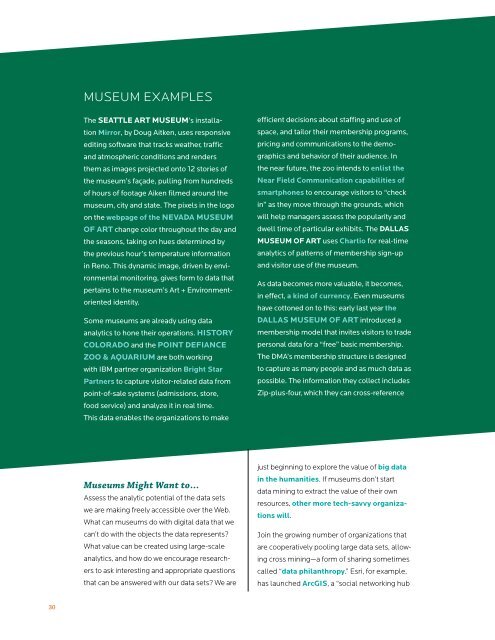1kLPuWX
1kLPuWX
1kLPuWX
You also want an ePaper? Increase the reach of your titles
YUMPU automatically turns print PDFs into web optimized ePapers that Google loves.
MUSEUM EXAMPLES<br />
The SEATTLE ART MUSEUM’s installation<br />
Mirror, by Doug Aitken, uses responsive<br />
editing software that tracks weather, traffic<br />
and atmospheric conditions and renders<br />
them as images projected onto 12 stories of<br />
the museum’s façade, pulling from hundreds<br />
of hours of footage Aiken filmed around the<br />
museum, city and state. The pixels in the logo<br />
on the webpage of the NEVADA MUSEUM<br />
OF ART change color throughout the day and<br />
the seasons, taking on hues determined by<br />
the previous hour’s temperature information<br />
in Reno. This dynamic image, driven by environmental<br />
monitoring, gives form to data that<br />
pertains to the museum’s Art + Environmentoriented<br />
identity.<br />
Some museums are already using data<br />
analytics to hone their operations. HISTORY<br />
COLORADO and the POINT DEFIANCE<br />
ZOO & AQUARIUM are both working<br />
with IBM partner organization Bright Star<br />
Partners to capture visitor-related data from<br />
point-of-sale systems (admissions, store,<br />
food service) and analyze it in real time.<br />
This data enables the organizations to make<br />
efficient decisions about staffing and use of<br />
space, and tailor their membership programs,<br />
pricing and communications to the demographics<br />
and behavior of their audience. In<br />
the near future, the zoo intends to enlist the<br />
Near Field Communication capabilities of<br />
smartphones to encourage visitors to “check<br />
in” as they move through the grounds, which<br />
will help managers assess the popularity and<br />
dwell time of particular exhibits. The DALLAS<br />
MUSEUM OF ART uses Chartio for real-time<br />
analytics of patterns of membership sign-up<br />
and visitor use of the museum.<br />
As data becomes more valuable, it becomes,<br />
in effect, a kind of currency. Even museums<br />
have cottoned on to this: early last year the<br />
DALLAS MUSEUM OF ART introduced a<br />
membership model that invites visitors to trade<br />
personal data for a “free” basic membership.<br />
The DMA’s membership structure is designed<br />
to capture as many people and as much data as<br />
possible. The information they collect includes<br />
Zip-plus-four, which they can cross-reference<br />
Museums Might Want to…<br />
Assess the analytic potential of the data sets<br />
we are making freely accessible over the Web.<br />
What can museums do with digital data that we<br />
can’t do with the objects the data represents?<br />
What value can be created using large-scale<br />
analytics, and how do we encourage researchers<br />
to ask interesting and appropriate questions<br />
that can be answered with our data sets? We are<br />
just beginning to explore the value of big data<br />
in the humanities. If museums don’t start<br />
data mining to extract the value of their own<br />
resources, other more tech-savvy organizations<br />
will.<br />
Join the growing number of organizations that<br />
are cooperatively pooling large data sets, allowing<br />
cross mining—a form of sharing sometimes<br />
called “data philanthropy.” Esri, for example,<br />
has launched ArcGIS, a “social networking hub<br />
30


